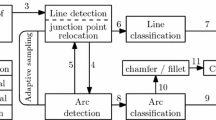Abstract
In this paper, we are concerned with the problem of finding a good and homogeneous representation to encode line drawing documents (which may be handwritten). We propose a method in which the problems induced by a first step skeletisation have been avoided. We first achieve a hierarchical representation that enables a fine description of the drawing using only pixels, vectors and quadrilateral primitives. This representation gives a global vision of the drawings. Then, its capacity to evolve and to carry high semantical local entities is highlighted. Finally we show how an architecture of perceptive cycles allows a better quality interpretation of the document.
Preview
Unable to display preview. Download preview PDF.
Similar content being viewed by others
References
Roosh, M. and Monagan, G. A high quality vectorisation combining local quality measures and global constraints. In: Proceedings of the 3rd ICDAR, Montreal (Canada), august 1995. Vol. 1, p. 243–248.
Vaxivière, P. Une vectorisation par maillage du dessin et séparation en calques, adaptée aux plans mécaniques. In: Proceedings of the 3e CNED, Rouen (France), juillet 1994. p. 205–214.
First international workshop on Graphics Recognition: Methods and applications. Lecture notes in computer sciences n. 1072. R. Kasturi, K. Tombre Eds. 308 pages. 1995.
Cugini, U., Ferri, G., Mussio, P. and Protti, M. Pattern directed restoration and vectorization of digitized engineering drawings. Computer and Graphics, 1984, Vol. 8, No 4, p. 337–350.
Tanigawa, S., Hori, O. and Shimotsuji, S. Precise line detection from an engineering drawing using a Fig. fitting method based on contours and skeletons. In: Proceedings of the 12th ICPR, Jérusalem (Israël), 9–13 octobre, 1994. Vol. 2, p. 356–360.
Shih, C. and Kasturi, R. Extraction of graphic primitives from images of paper based line drawings. Machine Vision and Applications, 1989, Vol. 2, p 103–113.
Wenyin, L. and Dori, D. Sparse Pixel Tracking:A fast vectorization algorithm applied to engineering drawings. 13th ICPR, Vienna (Austria), 1996. Vol. 3, p. 808–812.
Tombre, K. Graphic Recognition — General context and Challenges. Pattern Recognition Letters. September, 1995, Vol. 16, p. 883–891.
Den Hartog, J., ten Kate, T., and Gerbrands, J. Knowledge-Based segmentation for automatic map interpretation. First international workshop on Graphics Recognition. Lecture notes in computer sciences n. 1072. R. Kasturi, K. Tombre Eds. 1995. p. 159–178.
Ramel, J.Y., Vincent, N. et Brun, and JM. Bézier curves as tool to describe kinetic drawings. In: Proceedings of the ICDAR, Ulm (Allemagne), août 1997.
Wall, K. and Danielsson, P. A fast sequential method for polygonal approximation of digitized curves. Cornputer Vision, Graphics and Image Processing, 1984, Vol. 28, p. 220–227.
Author information
Authors and Affiliations
Editor information
Rights and permissions
Copyright information
© 1998 Springer-Verlag Berlin Heidelberg
About this paper
Cite this paper
Ramel, J.Y., Vincent, N., Emptoz, H. (1998). A coarse vectorisation as an initial representation for the understanding of line drawing images. In: Tombre, K., Chhabra, A.K. (eds) Graphics Recognition Algorithms and Systems. GREC 1997. Lecture Notes in Computer Science, vol 1389. Springer, Berlin, Heidelberg. https://doi.org/10.1007/3-540-64381-8_38
Download citation
DOI: https://doi.org/10.1007/3-540-64381-8_38
Published:
Publisher Name: Springer, Berlin, Heidelberg
Print ISBN: 978-3-540-64381-4
Online ISBN: 978-3-540-69766-4
eBook Packages: Springer Book Archive




